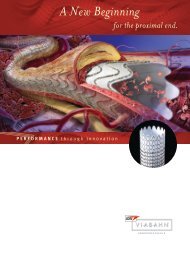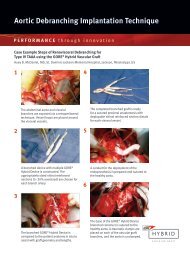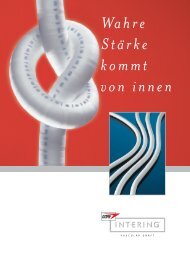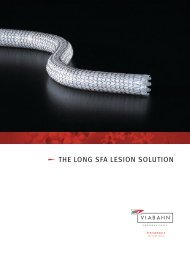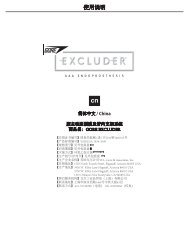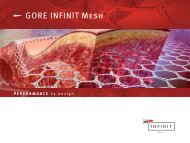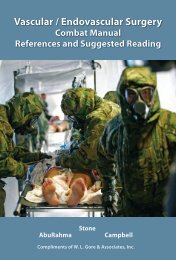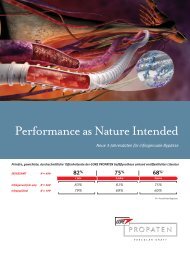Instructions for Use - Multilingual - Gore Medical
Instructions for Use - Multilingual - Gore Medical
Instructions for Use - Multilingual - Gore Medical
Create successful ePaper yourself
Turn your PDF publications into a flip-book with our unique Google optimized e-Paper software.
INSTRUCTIONS FOR USE<br />
GORE® Hybrid Vascular Graft<br />
I. DEVICE DESCRIPTION<br />
The GORE® Hybrid Vascular Graft is an ePTFE vascular prosthesis that<br />
has a section rein<strong>for</strong>ced with nitinol. The nitinol rein<strong>for</strong>ced section<br />
is partially constrained to allow <strong>for</strong> easy insertion and deployment<br />
into a vessel. The constraint is made up of an ePTFE fiber which is<br />
knitted into a tubular shape. The GORE® Hybrid Vascular Graft has<br />
a continuous lumen and has immobilized heparin bonded to the<br />
luminal surface.<br />
Figure 1: GORE® Hybrid Vascular Graft with the<br />
constrained nitinol rein<strong>for</strong>ced section<br />
Deployment Line<br />
Figure 2: GORE® Hybrid Vascular Graft fully deployed<br />
Nitinol Rein<strong>for</strong>ced Section<br />
II. INDICATIONS FOR USE<br />
GORE® Hybrid Vascular Grafts are intended <strong>for</strong> use as vascular<br />
prostheses <strong>for</strong> replacement or bypass of diseased vessels in<br />
patients suffering occlusive or aneurysmal diseases, in trauma<br />
patients requiring vascular replacement, <strong>for</strong> dialysis access, or <strong>for</strong><br />
other vascular procedures.<br />
III. CONTRAINDICATIONS<br />
1. DO NOT use the GORE® Hybrid Vascular Graft in patients with<br />
known hypersensitivity to heparin, including those patients<br />
who have had a previous incidence of HIT type II.<br />
2. DO NOT use any configuration of GORE® Hybrid Vascular<br />
Grafts <strong>for</strong> coronary artery bypass or cerebral reconstruction<br />
procedures.<br />
3. DO NOT use GORE® Hybrid Vascular Grafts as a patch. If cut<br />
and used as a patch, GORE® Hybrid Vascular Grafts may lack<br />
adequate transverse strength.<br />
FOR PATCHING APPLICATIONS:<br />
For cardiovascular procedures requiring patch materials, use the<br />
appropriate GORE® ACUSEAL Cardiovascular Patch.<br />
IV. PACKAGE HANDLING<br />
Store in a cool dry place. This product has an expiration date<br />
and should be used be<strong>for</strong>e the labeled “use by” (expiration) date<br />
marked on the box. The foil pouch is both a moisture barrier and<br />
a sterile barrier. DO NOT use or store the graft if the foil pouch has<br />
been compromised.<br />
The GORE® Hybrid Vascular Graft is designed <strong>for</strong> single use only;<br />
do not reuse device. <strong>Gore</strong> does not have data regarding reuse<br />
of this device. Reuse may cause device failure or procedural<br />
complications including device damage, compromised device<br />
biocompatibility, and device contamination. Reuse may result in<br />
infection, serious injury, or patient death.<br />
To open the package, peel open the foil pouch and remove the<br />
tray. Beginning at one corner, peel back the tray lid and gently<br />
remove the graft. <strong>Use</strong> clean gloves and atraumatic instruments<br />
when handling the graft.<br />
1<br />
Inspect the device <strong>for</strong> deployment line entanglements, loops<br />
or knots prior to use. The deployment line may get entangled,<br />
looped or knotted during shipping and could hinder deployment<br />
of the nitinol rein<strong>for</strong>ced section. If observed, deployment line<br />
entanglements, loops or knots must be carefully untied prior to<br />
use.<br />
V. TECHNICAL INFORMATION<br />
A. The luminal surface of the GORE® Hybrid Vascular Graft is<br />
bonded with fractionated active heparin of porcine origin.<br />
B. The presence of heparin on the GORE® Hybrid Vascular Graft is<br />
not intended to serve as an alternative to the surgeon’s chosen<br />
intraoperative or postoperative anticoagulation regimens.<br />
The physician should consider the need <strong>for</strong> intraoperative<br />
and / or postoperative anticoagulation therapy based on the<br />
pharmacological requirements and medical history of the<br />
patient. Effective anticoagulation and antiplatelet therapy<br />
should be maintained at a dosage deemed appropriate by<br />
physician.<br />
C. In the event of graft occlusion, established vascular prosthesis<br />
revision procedures should be considered. Appropriate<br />
revision procedure selection should be determined by the<br />
physician based on the specific case requirements. DO NOT<br />
CUT THE NITINOL REINFORCED SECTION.<br />
D. DO NOT LET THE LUMINAL SURFACE OF THE GORE® HYBRID<br />
VASCULAR GRAFT DRY ONCE IT HAS BEEN WETTED.<br />
E. With any vascular procedure, the possibility of HIT may exist.<br />
The incidence of HIT type II is extremely low in vascular<br />
bypass patients receiving heparin over a period of several<br />
days. If HIT type II is diagnosed, established procedures<br />
<strong>for</strong> the treatment of this condition, including immediate<br />
cessation of systemic heparin administration, should be<br />
followed.1,2,3 If symptoms persist, or the health of the patient<br />
appears compromised, alternative pharmaceutical or surgical<br />
procedures, including ligation or removal of the graft, may be<br />
considered at the discretion of the attending physician.<br />
F. CORONARY ARTERY BYPASS PROCEDURES<br />
(Also refer to Indications <strong>for</strong> <strong>Use</strong> and Contraindications )<br />
W. L. <strong>Gore</strong> & Associates, Inc., has insufficient clinical and<br />
experimental data upon which to base any conclusion<br />
regarding the use of GORE® Hybrid Vascular Grafts in coronary<br />
artery bypass procedures.<br />
G. AXILLOFEMORAL, FEMOROFEMORAL, and AXILLOBIFEMORAL<br />
BYPASS PROCEDURES<br />
The success of axillofemoral, femorofemoral, and<br />
axillobifemoral bypasses depends in large part on the<br />
implantation technique. Specific complications associated<br />
with improperly implanted GORE® Hybrid Vascular Grafts<br />
in these positions may include suture hole elongation and<br />
mechanical disruption or tearing of the graft, suture line, or<br />
host vessel. Failure to follow these techniques may result<br />
in extreme blood loss, loss of limb function, loss of limb, or<br />
death. Although experience indicates that the incidence<br />
of these complications is extremely low, the following<br />
techniques MUST be employed if your treatment plan<br />
includes one of the above procedures:<br />
• Consider the patient’s body weight and posture when<br />
determining the lengths of the tissue tunnel and the graft.<br />
• Drape the patient to allow full movement of the arm,<br />
shoulder girdle or legs when determining correct graft<br />
length.<br />
• Avoid protracted hyperabduction of the arm. Prolonged<br />
hyperabduction may lead to brachial plexus injury.<br />
• Allow sufficient length to avoid stressing the axillary<br />
or femoral anastomoses throughout the full range of<br />
movement of the arm, shoulder girdle, or legs. Surgeons<br />
suggest that the graft be placed under both the pectoralis<br />
major and pectoralis minor.<br />
• Cutting the graft slightly longer than necessary has been<br />
reported by some surgeons to reduce further the risk of<br />
stressing the graft or the anastomoses.<br />
• Correctly bevel the axillary anastomosis. Stress on the graft<br />
is minimized when the graft is placed parallel (0°) to the<br />
axillary artery. There<strong>for</strong>e, the anastomotic angle should be<br />
as small as possible and should not exceed 25° relative to<br />
the cut edge of the graft.<br />
• Anastomose the graft close to the rib cage on the first<br />
portion of the axillary artery. Do not place the anastomosis<br />
on the third portion of the axillary artery.




